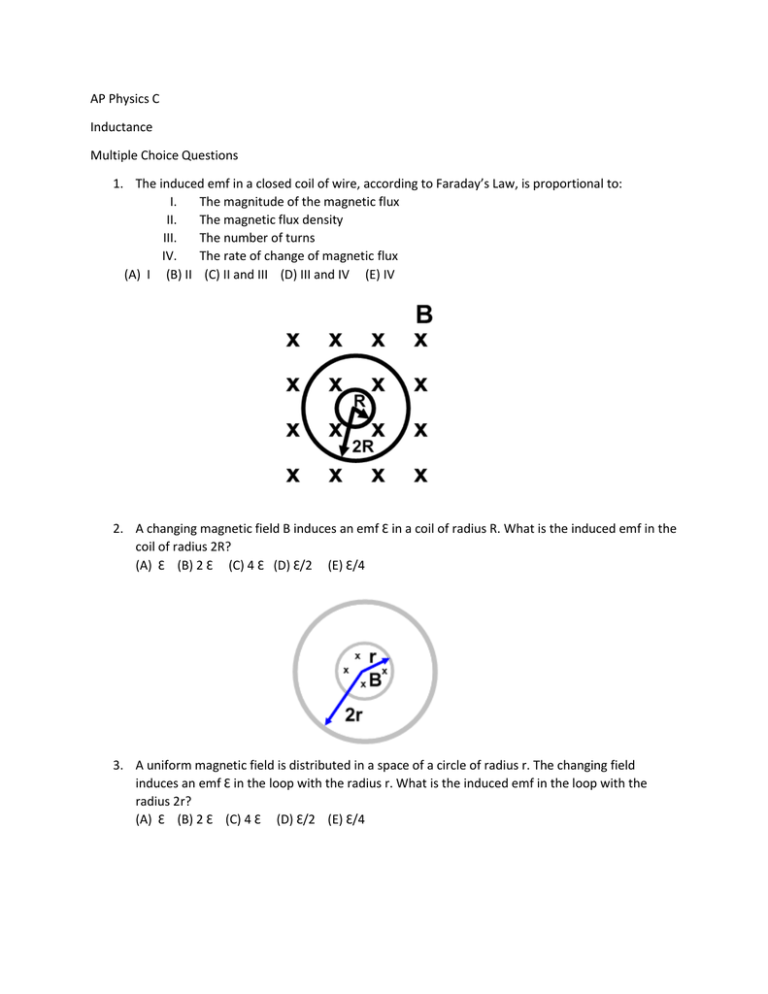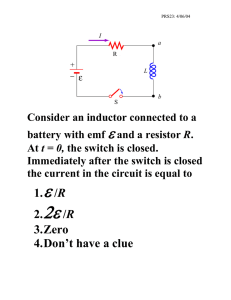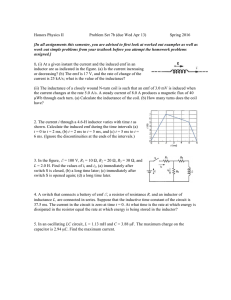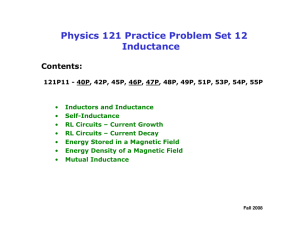AP Physics C Inductance Multiple Choice Questions 1. The induced
advertisement

AP Physics C Inductance Multiple Choice Questions 1. The induced emf in a closed coil of wire, according to Faraday’s Law, is proportional to: I. The magnitude of the magnetic flux II. The magnetic flux density III. The number of turns IV. The rate of change of magnetic flux (A) I (B) II (C) II and III (D) III and IV (E) IV 2. A changing magnetic field B induces an emf Ɛ in a coil of radius R. What is the induced emf in the coil of radius 2R? (A) Ɛ (B) 2 Ɛ (C) 4 Ɛ (D) Ɛ/2 (E) Ɛ/4 3. A uniform magnetic field is distributed in a space of a circle of radius r. The changing field induces an emf Ɛ in the loop with the radius r. What is the induced emf in the loop with the radius 2r? (A) Ɛ (B) 2 Ɛ (C) 4 Ɛ (D) Ɛ/2 (E) Ɛ/4 4. The number of turns in a long solenoid is doubled, how does the inductance of the solenoid change? (A) It doesn’t change (B) It doubles (C) It quadruples (D) It is cut to a half (E) It is cut to a quarter 5. Which of the following is true about the inductors? I. They store energy over a long time II. They resist the flow of current through it III. They can produce a magnetic field (A) I (B) III (C) I and II (D) II and III (E) All of the above 6. Which of the following can act as an inductor? I. A long coil II. A long wire III. A conducting sphere (A) I (B) III (C) I and II (D) II and III (E) All of the above 7. At time t =0 the switch is closed. Which of the following graphs best describes the voltage V across the resistance R as a function of time t? (A) (B) (C) (E) (D) 8. If L is inductance measured in H (Henry), what is 1 H is equivalent to? (A) 1 V∙s/A (B) 1 A/V∙s (C) 1 A∙V/s (D) 1 A∙∙s/V (E) 1 s/A∙V 9. If R is 1 Ω and L is 1 H, then L/R is (A) 1 V (B) 1 F (C) 1 A (D) 1 C (E) 1 s 10. In the circuit above, what is the instantaneous current at point P after the switch is closed? (A) Ɛ/R (B) 2Ɛ/R (C) Ɛ/2R (D) LƐ/R (E) 0 11. In the circuit above, what is the current at point P after the switch is closed for a long time? (A) Ɛ/R (B) 2Ɛ/R (C) Ɛ/2R (D) LƐ/R (E) 0 12. The switch is closed for a long time in the circuit above, what is the energy stored in the inductor? (A) LƐ/2R (B) LƐ2/2R2 (C) LƐ2/2R (D) LƐ/2R2 (E) L2Ɛ2/2R 13. An electric circuit consists of a battery of emf Ɛ, a resistor R and an inductor L. Which of the following represents the time constant? (A) R/L (B) RL (C) Ɛ/RL (D) Ɛ/L (E) L/R 14. An electric circuit consists of a battery of emf Ɛ, a resistor R and an inductor L. The circuit has a time constant τ. When another identical resistor R is connected in parallel to the first one, what is the new time constant? (A) τ (B) 2τ (C) 4τ (D) τ/2 (E) τ/4 15. A resistor R, an inductor L and a battery Ɛ are connected in series. Which of the following represents the Kirchhoff’s loop rule for the given circuit? 𝑑𝑖 (A) 𝐿 𝑑𝑡 𝑑𝑖 (B) iR + 𝐿 𝑑𝑡 (C) iR 𝑑𝑖 (D) iR - 𝐿 𝑑𝑡 𝑑𝑖 (E) Ɛ- iR - 𝐿 𝑑𝑡 =0 16. In the circuit above, initially the switch is open and then it is closed at time t =0. What is the current in the resistor at this time? (A) 3 A (B) 1 A (C) 0 (D) 0.5 A (E) 0.3 A 17. In the circuit above, the switch has been closed for a long time, then it is reopened at time t =0. Which of the following graphs best represents the electric current i as a function of time t? (A) (B) (C) (E) (D) 18. In the circuit above, the switch is closed for a long time. What is the energy stored in the inductor? (B) 3 J (B) 6 J (C) 18 J (D) 24 J (E) 36 J 19. An inductor of inductance of 2 H is connected in series to a resistor of 10 Ω and a 12 V battery. What is the time constant of the circuit? (A) 5 s (B) 10 S (C) 0.2 s (D) 0.1 s (E) 0.6 s 20. An inductor of inductance of 0.4 H is connected in series to a resistor of 6 Ω and a 12 V battery. What is the energy stored in the inductor? (A) 0.8 J (B) 1.2 J (C) 1.8 J (D) 2.4 J (E) 3.2 J 21. In the circuit above, at time t=0 the switch is placed in the position A. What is the current in the resistor at this time? (A) 0.3 A (B) 0.6 A (C) 0 (D) 3 A (E) 6 A 22. In the circuit above, at time t=0 the switch is placed in the position A. What is the voltage across the resistor at this time? (A) 3 V (B) 6 V (C) 9 V (D) 12 V (E) 0 23. In the circuit above, the switch has been kept at the position A for a long time and then at time t=0 is placed at the position B. What is the current in the resistor at this time? (A) 0.3 A (B) 0.6 A (C) 0 (D) 3 A (E) 6 A 24. In the circuit above, a fully charged capacitor with a capacitance C = 25 µF and charge Q = 4 µC is connected to an inductor L = 10 mH? What is the current in the circuit at the instant when the switch is closed? (A) 1 A (B) 5 A (C) 0 (D) 10 A (E) 15 A 25. In the circuit above, a fully charged capacitor with a capacitance C = 25 µF and charge Q = 4 µC is connected to an inductor L = 10 mH? Which of the following occurs after the switch is closed? (A) The charge instantaneously vanishes (B) The charge exponentially decreases to zero (C) The charge stays unchanged (D) The charge oscillates with a period of π ms (E) The charge oscillates with a period of π µs Answer Key 1. D 2. C 3. A 4. C 5. D 6. A 7. B 8. A 9. E 10. E 11. A 12. B 13. E 14. B 15. E 16. C 17. A 18. C 19. C 20. A 21. C 22. E 23. A 24. C 25. D






